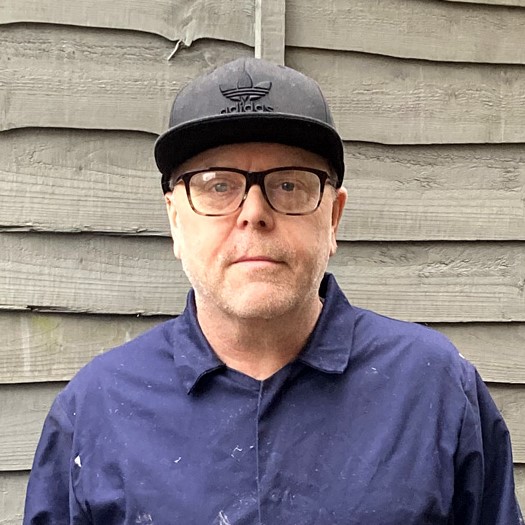What is sugar soap? Discover the benefits it will bring to your DIY projects
What is sugar soap? It’s a multi-talented, very effective cleaning solution that will give a solid base to your paint projects and beyond

If you are asking yourself What is sugar soap, then you need to find out what you have been missing out on. When working on any DIY project, preparation is the key to success. And sugar soap has a major part to play in the process, especially on paint projects.
Before painting a wall or woodwork, using sugar soap helps remove the build up of dirt and grease and leaves behind a surface that is ready to prep and paint. But, it's not just painted surfaces that can benefit from the power of sugar soap.
Here the pros reveal where you can use it, when and why you should use it and how to use it.

Michael has years of experience within the painting industry, evolving The Paint Shed from painting contractors to retailers. He uses his expertise to choose the best possible tools and materials for any DIY project.
What is sugar soap?
Sugar soap is a mild detergent that is ideal for cleaning paintwork to improve adhesion before you add any new paint. But the obvious question is, is there any sugar in sugar soap? No, it gets its name from the fact that in its powdered form it looks a bit like sugar – it's white and has small crystals.
It typically contains sodium carbonate or sodium hydroxide. Both are water soluble and help remove dirt and grease from paintwork. You can get sugar soap in dried or concentrated liquid form with the dried form being slightly cheaper. This makes it ideal if you are cleaning down very large areas.
The liquid concentrate is the more popular choice as it's really simple to use. You simply add the concentrate to a bucket of warm water and it's ready to go.
A typical example would be around 150ml of sugar soap to 5 litres of water. But you can add a little more to get a stronger solution for stubborn dirt and grease. (Bear in mind, you should wear rubber gloves, especially if you have sensitive skin)
Sugar soap solutions for a deep clean

A non-toxic and biodegradable sugar soap. Add 50ml to 4.5 litres of water to use.
What can sugar soap clean?
While commonly used for cleaning painted walls and woodwork ready for painting, sugar soap tackles almost anything as Georgina Shepherd of Housekeep shares, “Sugar soap contains fat-dissolving compounds which makes it incredibly effective in tackling greasy residue, stubborn grime and even nicotine stains from surfaces.”
It’s a great choice for painted wood as Micheal Rolland of The Paint Shed reveals, “Sugar soap can be used on wood, and often is a good choice. Bartoline sugar soap spray would be my go-to suggestion.” But be careful as Shepherd shares, “You can use sugar soap on wooden surfaces with the exception of unsealed wood.”
But while a great all-round, sugar soap is not as effective on mould as Rolland explains, “Sugar soap can remove visible mould. However, it is not the correct product for permanently killing or preventing mould spores, meaning it will not fix the problem in the long term.
Instead he suggests, “A bleach or white vinegar solution is a better alternative for killing mould.”
How to use sugar soap
Once you have made up your sugar soap solution you will need a small sponge – a sponge or kitchen scourer is a good choice. You can use the sponge for general cleaning and the scourer if you hit a stubborn spot. Alternatively, use a clean absorbent cloth but not paper towels.
Dip the sponge or cloth in the solution, squeeze to remove some of the solution so you have a damp cloth and start wiping from side to side and work your way down. Once you have wiped clean the area with sugar soap, get a clean cloth and rinse the area with clean warm water and leave to dry.
Try these to help apply sugar soap

A 5-pack of 750ml spray bottles with measuring gauge on side. An adjustable nozzle makes it ideal for adding your own mix of sugar soap and applying to walls or woodwork.

Georgina is a home cleaning expert at Housekeep. She's interviewed thousands of the UK’s best cleaners and tradespeople, along the way learning the top tricks of the trade.
Is sugar soap bad for the environment?
Sugar isn’t a naturally occurring or organic product as Shepherd points out, “Despite its name, sugar soap doesn’t actually contain any sugar, so it isn’t as natural as you might expect.” She adds, “Many brands now offer non-toxic or eco-friendly versions though, so always check the label.”
But while not considered hazardous it stills need to be used carefully as Rolland shares, “Sugar soap isn’t classified as environmentally hazardous unless a large volume of it is spilt.”
Sugar soap alternatives
There are different cleaning options if you don’t have sugar soap to hand. Shepherd suggests, “A paste of baking soda and water makes a gentle alternative, that can remove light grime. Although, it’s not as effective as sugar soap in removing tough grease and staining.” Rolland says, “Simply use your finger on a stain and gently rub the mark to lift the stain.”
Shepherd says, “A mixture of equal parts vinegar and water is another DIY option.” But she adds a note of caution, “Vinegar can damage paint, so it’s best used on surfaces that you’re planning to repaint.”
Rolland suggests washing up liquid, but it has to be used correctly as he explains, “Washing liquid must be thoroughly washed off. Otherwise, it can defeat the object of prepping your foundation, ruining the final finish of your paint.”
A cheap and easy alternative is Soda crystals, which you can buy on Amazon. They contain sodium carbonate, are biodegradable and you will typically find them in your local supermarket at a price that is typically cheaper than sugar soap. All you need to do is add to warm water – like sugar soap. Add a couple of cups to a few litres of water and stir. Wear rubber gloves to protect your skin.
But you can beat sugar soap, says Rolland, “Whilst some alternatives can do an equally good job if used correctly, sugar soap is one of our most recommended products for cleaning and preparing walls.”
Sugar soap v other cleaning liquids
Sugar soap is a top notch cleaner but you can use other household cleaners such as washing up liquid and bleach. Shepherd explains how bleach stacks up against sugar soap, “Bleach is great for brightening surfaces and disinfecting, but it’s not the best choice when it comes to cutting through grease or grime.”
She adds, “Bleach is also far too harsh for wood surfaces. It can strip away the natural finish, discolour the wood, and weaken its structure.”
Washing up is a gentler solution but, “Struggles with heavy-duty dirt buildup” says Shepherd. Rolland adds, “Washing up liquid leaves behind a soapy residue which can affect paint quality.”
Where can I buy sugar soap?
If you are on the lookout for sugar soap there are plenty of places where you can pick it up. This Bartoline Sugar Soap Concentrate Flask (500ml) is available from B&Q for around £6. If looking to buy in bulk, and save, you can get a pack of 3 Everbuild SOAPLIQ Sugar Soap Liquid for around £9.
You can get sugar soap from most local hardware stores including Homebase where you can ignore the concentrate and go for the quick and convenient option and invest in Bartoline Sugar Soap Wipes. But a more economical option is to invest in sugar soap powder and mix up yourself. This 1.5kg box of Bartoline Traditional Sugar Soap Powder from B&Q can make up to 30 litres of sugar soap.
FAQs
How long after using sugar soap can I paint?
This depends on what surface you are cleaning with sugar soap. If you are cleaning woodwork, before painting skirting boards for instance, you will be able to start much quicker than if you are cleaning painted walls.
Once you have cleaned and rinsed woodwork you can wipe down with a clean dry cloth to speed up how long you need to wait. You should be able to start painting after 30 minutes, or maybe even sooner. Check the woodwork is completely dry before starting.
If washing down painted or wallpapered walls leave for around an hour before you start painting. Again check that the walls are completely dry, if not leave until they are. (Ventilating the room can help here.)

Should I use sugar soap before wallpapering?
If you have removed old wallpaper then there may well be old wallpaper paste residue left on the walls. If this is the case use sugar soap to scrub down the walls to get rid of it. Remember to rinse and leave to dry.
If you have nice newly plastered walls you shouldn’t need to wash them down with sugar soap. However, when painting new plaster you will need to apply a mist coat before you start painting to help seal the plaster.
Does sugar soap clean gloss paint?
The simple answer to this is yes it does. You can use it to just clean your gloss paint, but after a few times it will start to take off the high sheen of even the best gloss paint. If using it to prep the woodwork for a new coat of paint then it won’t matter.
Sugar soap is a great all round degreaser and cleaner and ideal for most DIY projects. Use it to clean painted walls, when painting over textured wallpaper and painting gloss kitchen cabinets, plus many other jobs around the home.
Get the Homebuilding & Renovating Newsletter
Bring your dream home to life with expert advice, how to guides and design inspiration. Sign up for our newsletter and get two free tickets to a Homebuilding & Renovating Show near you.
Steve Jenkins is a freelance content creator with over two decades of experience working in digital and print and was previously the DIY content editor for Homebuilding & Renovating.
He is a keen DIYer with over 20 years of experience in transforming and renovating the many homes he has lived in. He specialises in painting and decorating, but has a wide range of skills gleaned from working in the building trade for around 10 years and spending time at night school learning how to plaster and plumb.
He has fitted kitchens, tiled bathrooms and kitchens, laid many floors, built partition walls, plastered walls, plumbed in bathrooms, worked on loft conversions and much more. And when he's not sure how to tackle a DIY project he has a wide network of friends – including plumbers, gas engineers, tilers, carpenters, painters and decorators, electricians and builders – in the trade to call upon.





